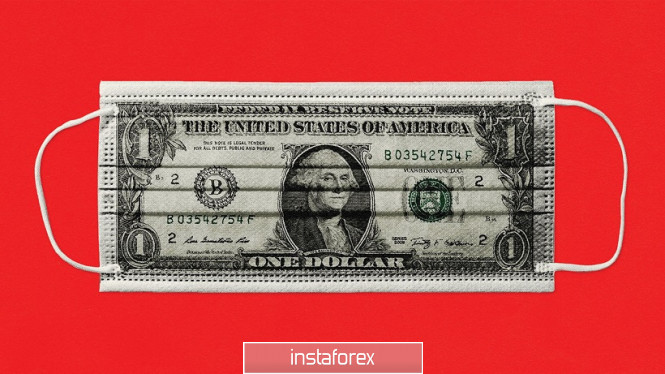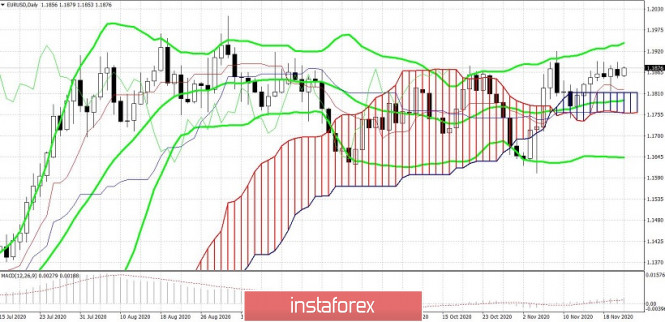The US dollar index continues to hold at multi-week lows at the bottom of the 0.92 level. The overall situation in the currency market remained unchanged at the end of the weekend. The key dollar pairs began to trade in almost the same positions where they were last Friday. However, the pound/dollar pair is an exception, which surged to the 33rd figure. The fact is that on Saturday, the UK and Canada reached an agreement on maintaining continuity in trade relations. The countries decided not to change the rules, keeping the flow of goods and services worth $ 27 billion. This fact has supported the pound, although key negotiations between London and Brussels are still unclear.
In turn, the euro-dollar pair has no significant changes. Traders continue to push within the area of the 0.18 level. TThe price has been alternately pushing back from the boundaries of the range for a week and a half, which narrowed to 1.1830-1.1890 by Friday. Neither bears nor bulls of EUR/USD managed to exit the range, although the corresponding attempts are made daily. In the end, the pair is marking time, amid contradictory fundamental outlook.
Technically, the US currency is still under pressure from coronavirus anti-records, political uncertainty (especially regarding the prospects for a new stimulus package), the Fed's "dovish" rhetoric, and weak macroeconomic reports (US retail sales and inflation).

The euro, on the other hand, is also affected negatively by COVID-19, albeit minimum. The European lockdowns are starting to turn out well. For example, the number of new cases of COVID-19 in France, which became the epicenter of the second wave of pandemic in Europe, has declined over the past 10 days and lowered the positive test results. According to the head of the French Ministry of Health, the situation was brought under control, and the peak of the second wave has already passed. The similar dynamics is observed in other EU countries.
Therefore, the main problem of the euro lies elsewhere now. It should be recalled that Hungary and Poland vetoed the adoption of the draft EU budget because of the new rules for the distribution of funds. This year, Brussels included in the document the obligation to observe the principles of the rule of law for the first time, and this fact alarmed the Hungarians and Poles. Human rights organizations regularly voice complaints against these countries: Hungary is criticized for a tough anti-immigration policy, while Poland for judicial reform and attempts to control the media. In view of such accusations, the countries may lose tens of billions of euros from EU funds, so they vetoed the budget adoption process, demanding to exclude the above principle. Unfortunately, the initial negotiations did not lead to anything. However, Slovenia supported Budapest and Warsaw, whose prime minister is a longtime ally of Viktor Orban, especially in the field of migration policy. For now, we can say that the situation has reached an impasse.
Therefore, the current growth of the EUR/USD pair is due only to the weakness of the US dollar, which is losing its positions throughout the market. The United States remains the focus of COVID-19 – if the daily increase in the number of cases did not fall below the 100-thousandth mark at the beginning of November, then last week, it did not fall below the 150-thousandth target. Recently, it has not dropped below the 170,000 mark. The news that vaccinations in the US could begin as early as December did not help the dollar. So, nothing will change in the medium term (at least until January-February), while the market is not used to assessing the situation of long-term prospects. Therefore, the US dollar index did not change its course during today's Asian session. It is gradually declining, due to the market's skeptical attitude towards the US currency.
This week's economic calendar for the EUR/USD pair does not contain many important releases, which are as follows:
- Monday, Nov 23 - PMI indices of key European countries
- Tuesday, Nov 24 - US consumer confidence
- Wednesday, Nov 25 - Personal consumption, expenditure index and the Fed's minutes of the last meeting.
- Thursday, Nov 26 - US Thanksgiving
- Friday, Nov 27 - None
Therefore, all investors' attention will be focused on the "main" topics: COVID-19, EU budget, a new aid package for the US economy and Brexit negotiations.
In my opinion, the priority for the EUR/USD pair remains with long positions. Firstly, the results of European lockdowns will be more clearly visible at the end of November: the curve of COVID-19 will likely to slowly decline. Second, the problem of blocking the EU budget is likely to be solved – in one form or another. If negotiations with representatives of Hungary and Poland finally reach an impasse, the EU may use alternative mechanisms. In particular, Brussels proposes to approve the parts that make up the budget through alternative channels that do not allow a veto by one of the countries. The European Union is also considering launching an economic recovery fund based on article 122 of the EU Treaty, which allows providing financial assistance to member States in emergency situations. There are other mechanisms for bypassing the block. Given this fact, we can conclude that Budapest and Warsaw will be more compliant, or Brussels will actually implement alternative scenarios.

From the point of view of technical analysis, long positions are of priority. The price on the daily chart is between the middle and upper lines of the Bollinger Bands indicator, as well as above all the lines of the Ichimoku indicator (including the Kumo cloud). All this suggests that the pair can be considered longs with the first goal at 1.1940 (upper line of the Bollinger Bands in the same time frame).
The material has been provided by InstaForex Company - www.instaforex.com